Articles
I have eight articles currently, the History of Music, the History of Midi, the History of my Musical Creations, the History of my BBC Micro Music, a Brief History of the Single, Technology and Media in 1996, Autographs and Tomorrow's World - The Jam Spreading Myth.
A Brief History of the Single - Part 1
When records were first developed in the late 19th century, they came in different sizes and played at a variety of speeds. By 1910 the 78rpm 10 inch shellac became the common format, holding around three minutes of music. 12 inch records were also made, holding 4 to 5 minutes of music, but still made of the rather brittle shellac. In 1931 RCA Victor introduced the long player, giving ten minutes of music per side, but made of a more durable plastic vinyl.
The 7 Inch Single
In 1949 RCA came up with the 7 inch single, holding around 3-5 minutes of music, in mono. It was only in 1958 that stereo (i.e. two channel) recording became possible but the format wasn't used that much until the late 60s.

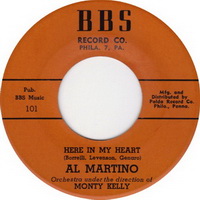

Lola Ameche - Takes Two To Tango 78 rpm, Al Martino - Here in my Heart and The Beatles - Love Me Do
In 1952 the charts for best selling singles began, with Al Martino's Here In My Heart being the first number one. Popular artists like Perry Como, Guy Mitchell, Frankie Laine, Doris Day and Frank Sinatra often got the prestigious number one spot. It wasn't until the 60s that British artists started to appear in the charts, like Cliff Richard and The Shadows, Gerry and the Pacemakers, Cilla Black and The Beatles.



7 inch spindle hole, 7 inch spindle hole push out and 7 inch juke box plastic adapter
The 7 inch single was yet to be seen as a promotion for an album, as many artists were signed up to release singles rather than albums. A feature of record shops in the early sixties was the listening booth. These were small soundproof cubicles where you could listen to a record before purchasing. Some had a record player so you could play a selection of records, but some were wired up and you had to ask the shop assistant to play a particular record. Others were just headphones with a push button selection. By the 1980s these disappeared, so if you wanted to listen to a song you had to ask the shop assistant and stand at the counter with headphones on. In the 60s, as bars and clubs became popular, juke boxes were the easy way to listen to music. To make it easier for the machines to place the record on the turntable, the hole in the middle was made bigger. Plastic adapters for ex juke box records were needed to play on the commercially available record players at the time. Some records were made with a small spindle hole which could be pushed out to leave the larger hole for juke box machines.
Radio was an important platform for the single and Pick of the Pops was a popular BBC radio program that featured the top 20 chart hits. Originally it began in 1955, with Franklin Engelmann as the host and then David Jacobs in 1956. It wasn't until Alan Freeman took over in 1961 that it became the show to listen to for the chart music. It eventually settled to a Sunday slot at 4pm and expanded to the top 40. From January 1964 to July 2006, Top of the Pops was the BBC television program, usually on a Thursday evening, where you could hear and see some of the best selling songs from the charts. It also included a chart rundown and went through many changes in the format. Initially you saw someone put the needle on the record before you saw the artist mime to the song. Later, singers sang to a backing track, and in another change to the format, the whole group had to play live. Until the introduction of the music video, artists who could not appear in the studio had their music danced to by a group, which changed over the years but the most famous troupes were Pan's People and Legs & Co. Most of the time an appearance on the show would boost sales of the single.
The covers for singles started out with a plain paper sleeve with a hole for the record label, which was also quite plain. The record companies then started putting their name on the sleeve and the labels on the records became more colourful. Then full colour sleeves were introduced with possibly a picture of the group on the front. This turned into a cardboard sleeve with elaborate designs. Gatefold covers were used when you could buy another record to form part of a set.


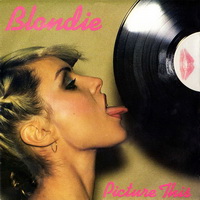



Plain paper record cover, printed paper cover and photo printed paper and cardboard covers
The labels on the records themselves were also a space for the designers to show their flair. Whilst originally the record label would have their own design for all their artists, later on the groups themselves had their own particular style. The Beatles were signed to Parlophone in the UK and Capitol Records in the US but in 1968 they started their own record label Apple Records, using an apple on the A side and a cut apple for the b side. The green apple changed colour when individual members of the group released their own music.
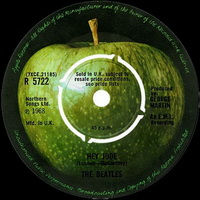







Apple Records label, EMI, Riva, Jewel Music, Beggars Banquet, Broken Records, Dindisc, London Records
The 12 Inch Single
It wasn't until the rise of disco music in the 70s that the 12 inch single was born. With the wider grooves and greater separation between them you could get a better quality recording. One of the first singles on 12 inch was Donna Summer's Love to Love You Baby. The increased space available meant that longer songs could be released, as singles could often be edited versions of the album track. Whilst many 12 inch releases were the same as the 7 inch, but sounded better, others had extended versions of the song, or a 12 inch mix. Some played at 33 1/3rpm (notably in the US) but most played at 45rpm to give a better treble response. Soon a variety of versions of the song would appear, from dance mix, dub mix, acappella (no instruments), instrumental (no vocals), extended or full.



12 Inch covers for I Will Survive, Da Ya Think I'm Sexy, Obsession, Kiss Me
With DJs using two turntables to mix between different versions, their own remixes became popular. They could be released as white label mixes, due to the plain label used on the record and the unofficial release of the track. Often the different formats would have different versions of the songs to encourage fans to buy multiple versions of the single. Some of these mixes were used to directly promote the album, with the cassette releases having the entire album on one side and the other filled with remixes. Two popular albums by the Thompson Twins, Quick Step and Side Kick and Into The Gap did this, so the only way to get these versions was to buy the cassette. Eventually the extra mixes appeared on the 12 inch singles from the album, although many appeared on official white label releases.
.jpg)
_record.jpg)

White Label details for Walk Live An Egyptian, The White Label, White Label details for You Take Me Up US 12" Remix
New Order
One band synonymous with the 12 inch single was New Order. Their record label, Factory Records, only released a few 7 inch singles, preferring to release the songs on long players or 12 inch singles. Blue Monday was released in 1983 but was not available on 7 inch until 1988. The song also didn't appear on the group's current album at the time, Power, Corruption & Lies, which made it even more popular. The cover didn't have the title of the song or the group's name on it and the packaging was made to look like a 5 and a 1/4 inch floppy disc, die cut with a silver inner sleeve. It was actually sold at a loss (around 5p per copy) so subsequent releases were made cheaper with no die cut.



Original Die Cut 12" for Blue Monday, The plain black version and the 1998 re-issue
ZTT
Another company who released multiple versions of songs was ZTT, the record label behind Frankie Goes to Hollywood, Propaganda and The Art of Noise. Frankie's Relax single was actually a remix of several different versions but it was their follow up single Two Tribes, that went straight to number one in June 1984, with many versions release on 7 inch, 12 inch and cassette. These were the Cowboys and Indians mix, We Don't Want To Die mix, both on 7 inch, Annihilation mix, Surrender mix, Carnage mix, Hibakusha mix, all on one of four 12 inch singles and Two Tribes (Keep The Peace) which was on cassette with a version called Two Tribes At Madison Square Garden. The version that appeared on their album was also different, but the story doesn't end there. In 1994 the track was reissued with Fluke's Minimix on 7 inch, Don't Want To Die (a Two Tribes mix under a different name), Fluke's Magimix, Fluke's Magimix Instrumental, Intermission Legend Mix, Intermission Legend Instrumental, Intermission Workout Mix, Intermission Workout Instrumental all on CD, Fluke's Moulimix and Teckno Prisoner Featuring Adamski mix on 12 inch. Then in 2000 another reissue saw Rob Searle Club Mix Radio Edit, Apollo Four Forty Remix Edit, Rob Searle Club Mix, Olav Basoski's Tiberium Power Mix, Rob Searle's Club Dub, Almighty Definitive Remix and Almighty Radio Edit. I'll save you counting, that's 26 versions released from 1984 to 2000.
_12_Inch.jpg)

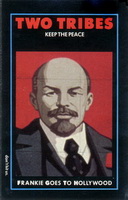





The many 12", 7", picture disc, cassette and CD issues of Two Tribes
Other labels would maybe only release two 12 inch singles with the single mix, b-side and maybe an instrumental on one and multiple remixes on the other. Some groups would encourage fans to buy their singles by incorporating a design that built up with each single. The Thompson Twins had their three head logo that was built up from the back cover design of the singles from Hold Me Now, Doctor Doctor, You Take Me Up and Sisters of Mercy.



The three head logo from four of the Thompson Twins 12" singles, the white vinyl double groove 10" of Basia's Promises, Octopus' Jealousy double groove


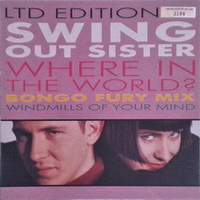
10" singles of Messages, Shout and Where in the World
Most of the time the 12 inch single cover looked the same as the 7 inch one, except for maybe some wording saying extended mix on the front. Depeche Mode often didn't stick to this, for example, the 7 inch and 12 inch versions of Leave in Silence looked very different. In fact, many of their early releases followed this trend with only the wording style being the same.




The 7" and 12" covers of Leave in Silence and New Life
One feature used to sell the single would be the double groove or multi-version. Instead of the one groove with one version of the song there would be two (or maybe more) grooves with different versions. As you placed the needle on the record you didn't know which version you would hear. A special 12 inch version of The Sugarcubes' single Birthday, released in 1988, features one groove containing the song Christmas Eve and the other containing Christmas Day; both are different recordings of the title track. The 12 inch single of Kate Bush's The Sensual World, released in 1989, had one track containing the standard vocal version and the other playing an instrumental version. Basia, the female vocalist who was in the group Matt Bianco released a 10 inch white vinyl, Promises/Give Me That, which has Promises (French Mix) and Give Me That on the same side. The b-side has the album mix of Promises.
Flexi Discs
I should mention flexi discs here as one famous multi groove track was "It's a Super-Spectacular Day" issued by MAD magazine in 1980. Flexi discs were thin plastic discs (or in some cases cardboard with a thin plastic coating) that were often given away with magazines and featured tracks that wouldn't normally be available. Music magazines like Flexipop (1980-1983) gave one away with each issue and New Musical Express featured them on occasions. Music technology magazines like Keyboard often gave them away before upgrading to the cover mounted compact disc. The one given with MAD magazine had eight different versions of the song, each starting the same but ending with a different disaster to the day.




Flexi Discs from MAD Magazine, Popswop, New Musical Express and Many Happy Returns cardboard flexi disc
Locked Groove
Another trick used was the continuous groove at the end of a single, sometimes known as a locked groove. Instead of the song fading out to silence it would play to the last groove which would play in a loop. Used by The Beatles on Sgt Peppers Lonely Heart's Club Band album it was also used on some singles such as The Beat by The Look, New Musik's Living by Numbers (a continuous synth sound) and Heaven 17's Penthouse and Pavement album's last track We're Going To Live For A Very Long Time, which loops on the phrase 'For A Very Long Time'.



Locked groove singles Living by Numbers, I Am the Beat and Muskrat Love

